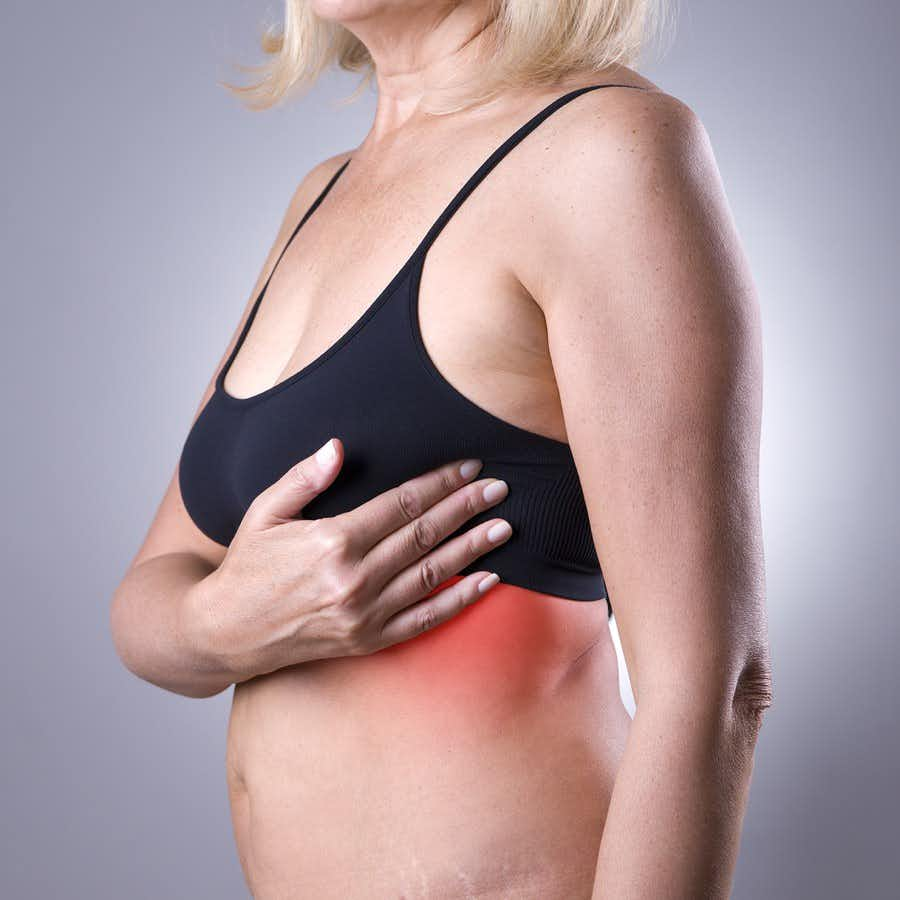
When weather gets hot and sticky, many people find their skin reacts in unpleasant ways. Rashes near the groin and under the breasts are especially common when the weather is hot and humid. What can you do to treat under-breast rash or jock itch?
A Cry for Help to Treat Under-Breast Rash:
Q. I have large breasts and have had an unpleasant rash under them for about a week now. I have tried a bunch of home remedies that I found on your website. Coconut oil was too greasy. Paper towels get stuck to my skin and baby powder leaves tiny clumps under my breasts. I even tried Desitin diaper rash cream but it dried the skin out too much. Do you have any other advice for me? I am feeling desperate.
Ways to Ease Uncomfortable Rashes:
A. Under-breast rash, or intertrigo, is an exceptionally common problem at this time of year. Heat and humidity encourage the growth of fungus that can cause a rash. It is the same type of organism that causes jock itch. While there are a number of approaches you can try to treat under-breast rash, we urge you to see a doctor and make sure that it is nothing more serious.
Athlete’s Foot Remedy for Under-Breast Rash:
Q. You have written about treating under-breast rash. I use Lotrimin with miconazole. When I first experienced the rash, my doctor prescribed a powder with miconazole. The prescription was a very small amount of powder, and the co-pay was not cheap.
One day I was in the drugstore and walked past the section where the athlete’s foot items were. I noticed that Lotrimin AF Athlete’s Foot Powder Spray contains miconazole. All I can say is, it works for me.
A. Many under-breast rashes are caused by yeast infections that respond well to an anti-fungal drug such as miconazole. These are the same agents that are effective against athlete’s foot.
There are several Lotrimin products. Some contain other antifungal ingredients including butenafine, clotrimazole or tolnaftate. Keeping the area dry with powder or zinc oxide cream can help discourage yeast from growing. Avoiding friction with an anti-chafing product may also prevent irritation.
Liquid Laxative (Milk of Magnesia) for Under-Breast Rash:
Q. I’ve had trouble at times with irritation under the breast and in the groin area. Thanks to your website, I found a great remedy–topical milk of magnesia.
I use it as a deodorant and I think it works better than branded deodorants. Using the hair dryer after applying it keeps it from running. It also helps the area under my breasts if I apply it daily. No more irritation!
A. Under-breast rash has a fancy medical name: inframammary intertrigo. It is usually associated with skin folds where sweat can accumulate and encourage the overgrowth of yeast.
Magnesium hydroxide (milk of magnesia) does not stop sweating as antiperspirants do. However, it does control odor if used in the armpits. We suspect that it may alter the balance of microbes on the skin. That might discourage the fungus that causes irritation.
Aluminum Antiperspirants vs. Under-Breast Rash?
We suspect that some people might try applying an antiperspirant or deodorant to control moisture in delicate places. We would discourage aluminum-based products around the breast, though. This topic is highly controversial.
An article in Current Medicinal Chemistry (Jan. 1, 2024) touches on the topic:
“The potential association between aluminum-containing deodorants/antiperspirants and breast cancer has been investigated and debated. This paper comprehensively analyzes existing literature to examine the evidence and provide insights into this relationship. This comprehensive review discusses aspects related to the absorption and distribution of aluminum compounds, its effects on the induction of oxidative stress, the estrogenic activity of aluminum, and potential disruption of hormonal pathways, and the potential role in breast cancer induction…Continued multidisciplinary research efforts and collaboration between researchers, regulatory bodies, and public health authorities are vital to developing a more definitive understanding of this complex topic.”
A review in the Journal of Trace Elements in Medicine and Biology, Sept. 2023 concluded:
“In light of the precautionary principle and based on the data obtained, it is better to avoid antiperspirants that contain Al [aluminum]. Deodorants without aluminum are not implicated in breast cancer, either clinically or fundamentally.”
Should you be interested in an aluminum-free deodorant, here is a link to our People’s Pharmacy Unscented Magnesium Rich Roll-On Deodorant.
Cetaphil Cleanser:
Some men have found that using Cetaphil cleanser for the affected area can help control jock itch. The propylene glycol it contains has antifungal activity. We would expect this cleanser to be equally effective in easing under-breast rash.
Hand Sanitizer:
One reader offered the following innovative approach:
“I have read your advice on the heat rash women often develop under their breasts. I myself have tried many things, but then I experimented with wiping the area twice a day with hand sanitizer.
“Applying hand sanitizer stings for a minute, but the rash dried up in far less than a week. If I am careful to use this remedy at the first sign of redness, the heat rash never really gets a start. I am sure the antibacterial activity of hand sanitizer is what makes it work so well.”
Although we have not seen research confirming that a rash under the breasts is caused by yeast, we suspect that is often the culprit. That is presumably why many women find that antifungal creams or powders help them overcome under-breast rash.
Dandruff Shampoo:
Another popular remedy is using dandruff shampoo to wash the skin that has the rash. Be gentle: fungal infections should not be scrubbed or irritated.
Original Listerine:
Other people, both men and women, have utilized the antifungal activity of old-fashioned amber Listerine for jock itch or to treat under-breast rash.
Smelly Bra Problem:
Rash is not the only troublesome problem women have reported. This reader finds that her bra smells nasty, even after just a few hours of wear.
Q. I am a large-breasted woman with an embarrassing issue. Whenever I wear a bra, by the time I take it off it smells bad. I have to wash the bra after just one wearing, even if for only a few hours. This is not like an underarm odor. Could it be a sign of a fungal infection?
Cornstarch under the breast doesn’t help. Would it be safe to try amber Listerine? I don’t want to use any risky chemicals.
Discourage Intertrigo:
A. Skin on skin friction, such as under the breasts, is called intertrigo (American Family Physician, April 2014). The resulting inflammation often creates a hospitable environment for fungi or even bacteria that could cause an unpleasant odor.
Wiping under the breasts with amber Listerine would be safe. We don’t know whether it would be comfortable, as it might sting irritated skin. Other women have reported treating under-breast rash with Cetaphil cleanser, hand sanitizer, dandruff shampoo, milk of magnesia or diaper rash ointment with zinc oxide.
You will probably need to continue washing your bras after each wearing at least until the condition clears up. You would not want to re-infect yourself.
Read on to learn what people have used for summertime rashes and irritations.
Elaine of North Carolina told her story:
“Listerine works wonders on this rash under the breasts. Apply it daily following a shower. It doesn’t hurt to apply it before bed as well.
“Once the Listerine has dried, pat on cornstarch or a good body powder without perfume. Results should be seen in less than a week. Once control has been established and rash disappears, apply Listerine every few days to maintain a rash-less state.”
Milk of Magnesia:
Jim in Virginia contributed this:
“I’ve had tremendous success with most skin irritations by just applying Milk of Magnesia. I’ve seen it work on shingles (mine), jock itch (my brother), a scalp rash that was diagnosed as a viral infection that persisted after two years of treatment (a business associate), diaper rash…you name it, it works. Amazing. I buy the generic version at the dollar store.”
Treat Under-Breast Rash With Antifungal Creams:
Some women find that OTC antifungal creams or ointments do the job, while others devise absorbent bra liners that can be replaced easily when they become damp. Remedies that work for diaper rash can often overcome under-breast rash as well.
Helen M. wrote:
“I am using a baby ointment with zinc oxide; when this is finished I plan to go to straight zinc ointment. I use the ointment every day, under my breasts, under my belly and in my groin. What with being diabetic, I have a tendency towards yeast infections. If one slips by my prevention methods, I use Bag Balm to treat it.”
Tea Tree Oil:
Some people like to use a lotion containing tea tree oil, which also fights fungus. Be careful, though. Tea tree oil can trigger an allergic reaction similar to contact dermatitis in sensitive people. That is the last thing you need in that delicate area.
Green Tea:
Here is one last suggestion, from another reader:
“Put two green tea bags in a medium size bowl with water. Let this sit for a couple of hours. Use a clean washcloth dipped in the solution as a cold compress a few times a day. I have used green tea bags in bath water when the kids had diaper rash, and it did wonders.”
Green tea also has antifungal properties (Pharmacognosy Magazine, 2009, vol. 5, issue 20). A key constituent of green tea, epigallocatechin-3-gallate aka EGCG, appears to disrupt folic acid metabolism in both bacteria and fungi (British Journal of Pharmacology, March 2013).
Citations
- Aladag H et al, "Antifungal activity of green tea leaves (Camellia sinensis L.) sampled in different harvest time." Pharmacognosy Magazine, [serial online] 2009 [cited 2019 Jul 29];5, Suppl S1:437-40. Available from: http://www.phcog.com/text.asp?2009/5/20/437/59772
- Steinmann J et al, "Anti-infective properties of epigallocatechin-3-gallate (EGCG), a component of green tea." British Journal of Pharmacology, March 2013. DOI: 10.1111/bph.12009
- Moussaron, A., et al, "Correlation between daily life aluminium exposure and breast cancer risk: A systematic review," Journal of Trace Elements in Medicine and Biology, Sept. 2023, DOI: 10.1016/j.jtemb.2023.127247
- Kalra MG et al, "Intertrigo and secondary skin infections." American Family Physician, April 2014.
- Hangan, T., et al, "Exploring the Potential Link between Aluminum-Containing Deodorants/Antiperspirants and Breast Cancer: A Comprehensive Review," Current Medicinal Chemistry, Jan. 1, 2024, DOI: 10.2174/0109298673269343231025070053


